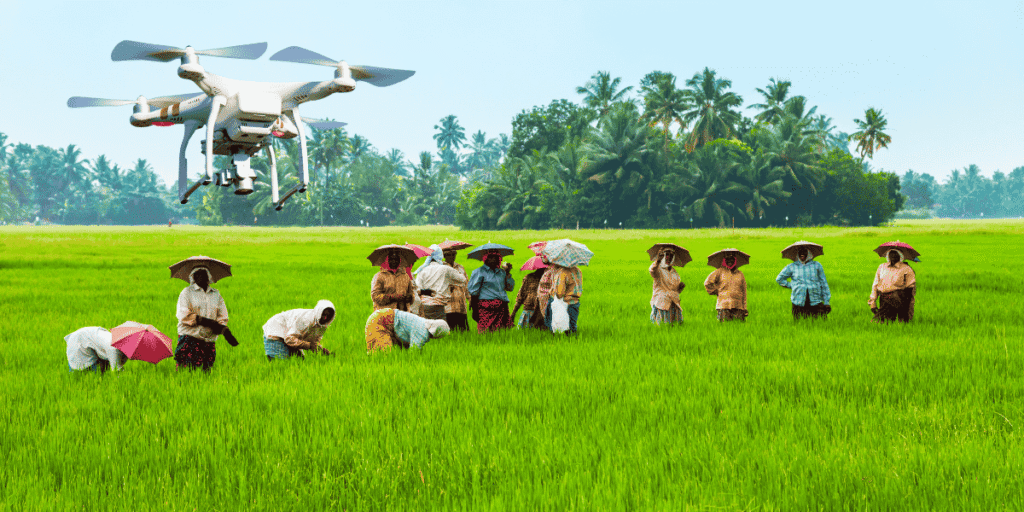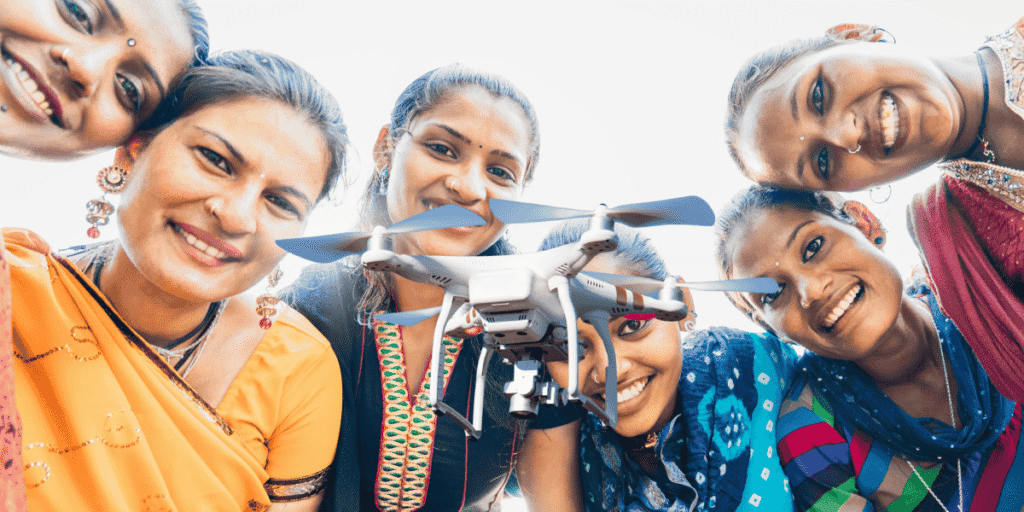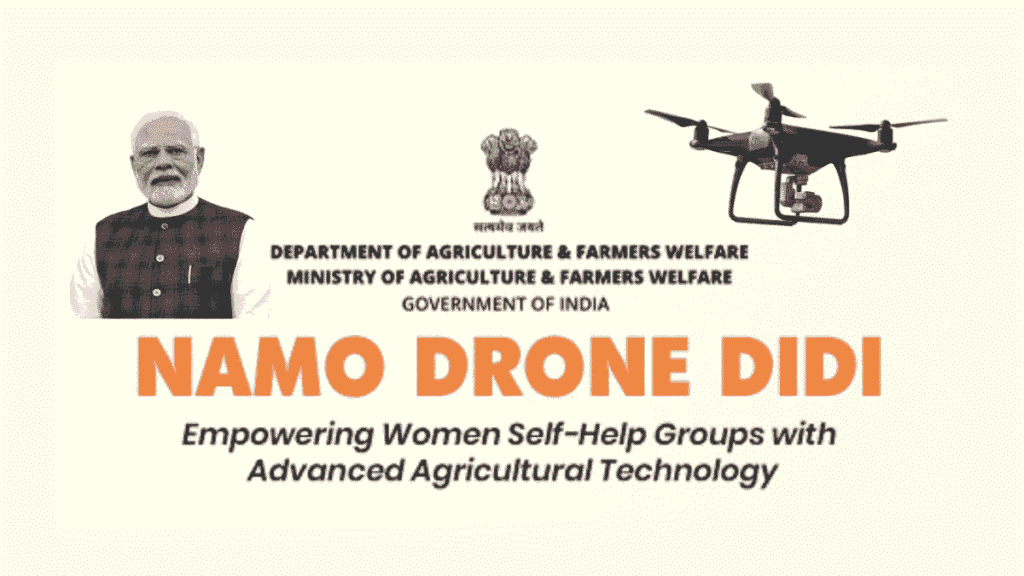The NaMo Drone Didi Scheme, launched by the Government of India, is a transformative initiative aimed at empowering rural women and modernizing agriculture through drone technology. By equipping women-led Self-Help Groups (SHGs) with drones and specialized training, the scheme fosters economic independence, enhances agricultural productivity, and bridges the gender gap in rural India.
This comprehensive guide explores the NaMo Drone Didi Scheme, its objectives, features, benefits, eligibility criteria, application process, and its impact on rural women and the agricultural sector.
Introduction to the NaMo Drone Didi Scheme
India’s agricultural sector is undergoing a technological revolution, with drones playing a pivotal role in transforming traditional farming practices. The NaMo Drone Didi Scheme, launched on November 30, 2023, by Prime Minister Narendra Modi, is a flagship program under the Sashakt Nari-Viksit Bharat initiative. It aims to empower 15,000 women-led SHGs by providing them with drones for agricultural services such as crop monitoring, pesticide spraying, and soil analysis. With a budget of ₹1,261 crore, the scheme operates from 2023-24 to 2025-26, aligning with the government’s vision of creating 3 crore “Lakhpati Didis”—women earning at least ₹1 lakh annually.
The NaMo Drone Didi Scheme integrates advanced technology into rural economies, empowering women to become drone pilots and entrepreneurs. By providing financial assistance, training, and access to cutting-edge tools, the scheme addresses challenges in agriculture while promoting gender equality and economic self-reliance. This article delves into the scheme’s operational framework, its impact on rural women, and its role in revolutionizing Indian agriculture.
Objectives of the NaMo Drone Didi Scheme

The NaMo Drone Didi Scheme has multifaceted objectives that align with India’s goals of women’s empowerment and agricultural modernization:
- Women’s Empowerment: Equip rural women with advanced skills in drone technology to foster financial independence and leadership in rural economies.
- Agricultural Modernization: Introduce drones for precision farming tasks like fertilizer and pesticide application, crop monitoring, and soil analysis to enhance productivity and reduce costs.
- Economic Growth: Enable SHGs to generate sustainable income by offering drone-based services to farmers, targeting an additional ₹1 lakh per year per SHG.
- Technological Integration: Promote the adoption of drone technology in rural areas, reducing the urban-rural technological divide.
- Entrepreneurship Development: Encourage women to establish drone-related businesses, contributing to the startup ecosystem and rural innovation.
These objectives align with the broader goals of the Deendayal Antyodaya Yojana-National Rural Livelihood Mission (DAY-NRLM), which focuses on poverty alleviation and women’s empowerment.
Key Features of the NaMo Drone Didi Scheme
The NaMo Drone Didi Scheme is designed with a comprehensive framework to ensure effective implementation and maximum impact. Key features include:
- Drone Distribution: The scheme aims to provide drones to 15,000 women-led SHGs from 2024-25 to 2025-26 for rental services to farmers, focusing on liquid fertilizer and pesticide application.
- Financial Assistance: Central Financial Assistance covers 80% of the drone cost, up to ₹8 lakh, with the remaining 20% accessible through loans from the Agriculture Infra Financing Facility (AIF) at a 3% interest subvention.
- Comprehensive Training: One member from each selected SHG undergoes a 15-day training program, including 5 days of mandatory drone pilot training and 10 days of additional training for agricultural applications like nutrient and pesticide spraying. Another member is trained as a drone technician for maintenance and repairs.
- Drone Package: Each SHG receives a complete drone package, including spray assemblies, batteries, cameras, chargers, and measurement tools, with a one-year warranty.
- Implementation Framework: The scheme is governed by an Empowered Committee comprising secretaries from the Ministries of Agriculture, Rural Development, Fertilizers, Civil Aviation, and Women and Child Development. An Implementation and Monitoring Committee, led by the Additional Secretary of Rural Development, ensures effective execution.
- Monitoring System: An IT-based Management Information System (MIS) facilitates service delivery and monitoring, ensuring transparency and accountability.
- Cluster-Based Approach: Drones are deployed in economically feasible clusters, with each SHG expected to manage 2,000–2,500 acres annually.
Scheme Features Table
| Feature | Details |
|---|---|
| Drone Distribution | 15,000 drones to women-led SHGs from 2024-25 to 2025-26 |
| Financial Assistance | 80% subsidy up to ₹8 lakh; AIF loans with 3% interest subvention |
| Training Duration | 15 days (5 days pilot training + 10 days agricultural application training) |
| Drone Package | Includes batteries, spray equipment, cameras, chargers, and one-year warranty |
| Governance | Empowered Committee and Implementation and Monitoring Committee |
| Monitoring | IT-based MIS for transparency and service delivery |
| Operational Area | 2,000–2,500 acres per SHG annually |
Benefits of the NaMo Drone Didi Scheme
The NaMo Drone Didi Scheme offers a wide range of benefits for women, farmers, and the agricultural sector:

For Women SHGs
- Economic Empowerment: SHGs can earn an additional ₹1 lakh annually by providing drone services, contributing to the “Lakhpati Didi” goal.
- Skill Development: Women gain expertise in drone operation, maintenance, and agricultural applications, enhancing their employability and entrepreneurial potential.
- Community Leadership: Trained “Drone Didis” become role models, inspiring other women in rural communities to embrace technology.
- Networking Opportunities: The scheme fosters collaboration through forums and workshops, connecting women with industry experts and mentors.
- Financial Independence: Subsidies and low-interest loans reduce financial barriers, enabling women to start drone-based businesses.
For Farmers
- Precision Agriculture: Drones enable accurate application of fertilizers and pesticides, reducing waste and environmental impact.
- Cost Efficiency: Drone services lower labor costs and improve efficiency compared to manual methods.
- Crop Monitoring: Drones provide real-time data on crop health, soil fertility, and irrigation needs, enabling data-driven decisions.
- Increased Yields: Precise application and timely interventions lead to higher crop productivity.
For the Agricultural Sector
- Technological Advancement: The scheme promotes drone adoption, aligning with India’s push for automation under Atmanirbhar Bharat.
- Sustainability: Drones reduce chemical overuse, supporting eco-friendly farming practices.
- Economic Growth: The scheme stimulates rural economies by creating new income streams and fostering innovation.
Benefits Comparison Table
| Stakeholder | Key Benefits |
|---|---|
| Women SHGs | ₹1 lakh annual income, skill development, leadership, networking opportunities |
| Farmers | Precision agriculture, cost efficiency, real-time data, increased yields |
| Agricultural Sector | Technological advancement, sustainability, economic growth |
Eligibility Criteria for the NaMo Drone Didi Scheme
To participate in the NaMo Drone Didi Scheme, SHGs and their members must meet specific eligibility criteria:
- SHG Membership:
- Income Requirements:
- Age and Education:
- Training Willingness:
- Cluster Selection:
Eligibility Criteria Table
| Criterion | Requirement |
|---|---|
| SHG Status | Registered under DAY-NRLM, selected by District/State Committee |
| Income | Annual household income ≥ ₹1 lakh, monthly ≥ ₹10,000 for 4 seasons/cycles |
| Age | 18–50 years for drone pilot/technician training |
| Education | Minimum Class 10 completion |
| Physical/Mental Fitness | Fit to undergo training and operate drones |
| Cluster Requirement | Operate in economically feasible clusters |
Application Process for the NaMo Drone Didi Scheme
The application process for the NaMo Drone Didi Scheme is straightforward but requires adherence to specific steps:
- Visit Official Portal:
- SHGs must visit the official NaMo Drone Didi Portal (namodronedidi.php-staging.com) or contact their nearest Gram Panchayat Office or Pradhan Mantri Kisan Samriddhi Kendra for information.
- Online Application:
- Document Submission:
- Submit required documents, including:
- SHG Registration Number
- Aadhaar cards of women members
- SHG bank account details
- Proof of income eligibility
- Submit required documents, including:
- Review and Submission:
- Selection and Training:
- Drone Distribution:
For details on drone insurance visit : Drone Insurance In India: A Complete Beginner’s Guide (2025 Edition)
Application Process Flowchart
| Step | Action |
|---|---|
| Step 1 | Visit NaMo Drone Didi Portal or local Gram Panchayat/Kisan Samriddhi Kendra |
| Step 2 | Access “Apply Now” and fill out the online application form |
| Step 3 | Submit documents (SHG registration, Aadhaar, bank details, income proof) |
| Step 4 | Review and submit the application |
| Step 5 | Await selection by District Committee |
| Step 6 | Complete 15-day training and receive drone with subsidy |
Implementation and Monitoring
NaMo Drone Didi Scheme is implemented through a collaborative effort involving multiple stakeholders:
- Nodal Ministry: Ministry of Agriculture & Farmers Welfare oversees the scheme’s execution.
- Supporting Ministries: Departments of Rural Development, Fertilizers, Civil Aviation, and Women and Child Development ensure holistic interventions.
- Lead Fertilizer Companies (LFCs): LFCs provide technical support and supply liquid fertilizers compatible with drone spraying.
- Krishi Vigyan Kendras (KVKs): KVKs facilitate training and technical guidance for agricultural applications.
- State Governments: States identify clusters, monitor SHG performance, and provide handholding support to manage 2,000–2,500 acres annually.
- Private Partners: Companies like Garuda Aerospace and Mahindra & Mahindra supply drones and conduct pilot training projects.
The IT-based MIS ensures real-time monitoring of drone distribution, training completion, and service delivery, enhancing transparency.
Impact of NaMo Drone Didi Scheme
As of now, the NaMo Drone Didi Scheme has made significant strides in empowering rural women and transforming agriculture:
- Women’s Empowerment:
- Over 1,000 drones were distributed to SHGs on March 11, 2024, with plans to reach 15,000 by 2026.
- In Uttar Pradesh, 216 clusters have been identified for drone deployment, benefiting numerous SHGs.
- Women trained as “Drone Didis” are earning ₹1 lakh annually, contributing to the goal of 3 crore Lakhpati Didis.
- Agricultural Productivity:
- Drones have reduced pesticide and fertilizer waste by up to 30%, improving crop yields by 10–15% in pilot areas.
- Real-time crop monitoring has enabled farmers to address pest infestations and nutrient deficiencies promptly.
- Economic Growth:
- Technological Adoption:
Impact Metrics Table
| Metric | Achievement (as of July 2025) |
|---|---|
| Drones Distributed | 1,000+ (target: 15,000 by 2026) |
| SHGs Benefited | 1,000+ SHGs, 216 clusters in Uttar Pradesh |
| Income Generated | ₹1 lakh per SHG annually |
| Crop Yield Improvement | 10–15% increase in pilot areas |
| Pesticide/Fertilizer Savings | Up to 30% reduction in waste |
Challenges and Solutions
Despite its successes, the NaMo Drone Didi Scheme faces challenges:
- High Initial Costs:
- Challenge: Even with subsidies, the 20% drone cost contribution can be a barrier for low-income SHGs.
- Solution: Expand AIF loan access and introduce microfinance options tailored for SHGs.
- Limited Awareness:
- Technical Complexity:
- Regulatory Compliance:
- Infrastructure Limitations:
Case Studies: Success Stories of NaMo Drone Didi
Case Study 1: Guntur, Andhra Pradesh
In March 2024, women SHGs in Guntur received drones under the NaMo Drone Didi Scheme. Trained as drone pilots, they provided pesticide spraying services to local farmers, covering 2,000 acres in one season. The SHGs earned ₹1.2 lakh collectively, with each member contributing to their household income. The precision spraying reduced pesticide use by 25%, benefiting both farmers and the environment.
Case Study 2: Himachal Pradesh
IIT Mandi’s Drone Didi program, launched in January 2024, trained 50 women from SHGs in drone operations for apple orchard management. The women used drones for soil analysis and irrigation monitoring, increasing orchard yields by 12%. The program, recognized by the National Skill Development Corporation, showcased the scheme’s potential to transform hilly regions.
Future Prospects of the NaMo Drone Didi Scheme
NaMo Drone Didi Scheme is poised to reshape India’s rural landscape by 2026:
- Scaling Up: With a target of 15,000 SHGs, the scheme will expand to more states, with Uttar Pradesh already identifying 216 clusters.
- Advanced Training: Plans to introduce modules on precision agriculture and AI-driven analytics will enhance drone applications.
- Startup Ecosystem: The scheme encourages drone manufacturing startups like Garuda Aerospace, boosting domestic production under Atmanirbhar Bharat.
- National Conference: A planned National Conference on Women in AgTech will further promote networking and innovation among Drone Didis.
- Global Impact: The scheme’s success could serve as a model for other developing nations, showcasing women-led agricultural innovation.
Practical Tips for SHGs Participating in the Scheme
- Engage with Local Authorities: Contact Gram Panchayats or KVKs for application guidance and cluster identification.
- Leverage Training: Ensure members complete the full 15-day training to maximize drone operation efficiency.
- Maintain Drones: Use free maintenance sessions offered by the scheme to extend drone lifespan.
- Market Services: Promote drone services to local farmers through community networks and Kisan Samriddhi Kendras.
- Stay Compliant: Obtain necessary DGCA certifications and adhere to drone operation regulations.
Also Read : Best Drone Insurance Companies In India
FAQs On Namo Drone Didi Scheme
Q1: What is the Namo Drone Didi Scheme?
Ans: The Namo Drone Didi Scheme is a government initiative aimed at empowering rural women by providing them training and access to agricultural drones. The scheme focuses on enhancing women’s participation in modern farming practices while boosting agricultural productivity.
Q2: Who launched the Namo Drone Didi Scheme and when?
Ans: The scheme was launched by the Government of India under the leadership of Prime Minister Narendra Modi in 2023 to promote women-led development in agriculture.
Q3: What is the main objective of the Namo Drone Didi Scheme?
Ans: The primary objective is to empower women Self-Help Groups (SHGs) by training them in operating drones for agricultural purposes such as spraying fertilizers, pesticides, and monitoring crop health.
Q4: Who is eligible to benefit from the Namo Drone Didi Scheme?
Ans: Women from Self-Help Groups (SHGs) across rural India are eligible to participate in the scheme. Priority is given to those actively involved in farming and allied activities.
Q5: How many women are expected to benefit under the scheme?
Ans: The scheme aims to benefit approximately 15,000 women SHGs, with each group receiving training and access to one drone for agricultural use.
Q6: What kind of training is provided under the Namo Drone Didi Scheme?
Ans: Women are trained in drone operation, maintenance, and safety protocols. They also learn how to use drones for spraying fertilizers and pesticides, monitoring crops, and ensuring precise agricultural practices.
Q7: How does the scheme improve agricultural productivity?
Ans: By using drones, farmers can apply fertilizers and pesticides more accurately, reduce wastage, save time, and increase crop yield. This leads to higher efficiency and lower costs in farming.
Q8: Are the drones provided free of cost under the scheme?
Ans: No. The government provides financial assistance and subsidies to SHGs to acquire drones, but they are not given entirely free. The cost-sharing model ensures ownership and responsibility.
Q9: What role do Self-Help Groups (SHGs) play in the scheme?
Ans: SHGs act as the primary beneficiaries. They are responsible for managing the drones, offering drone services to farmers in their villages, and generating income through these services.
Q10: How does the Namo Drone Didi Scheme promote women empowerment?
Ans: By equipping women with technical skills, the scheme opens new income opportunities, enhances decision-making roles in agriculture, and reduces gender disparity in rural communities.
Q11: What financial assistance is available under the scheme?
Ans: The government provides subsidies, training costs, and partial funding for the purchase of drones. SHGs may also access soft loans through banks to cover the remaining costs.
Q12: Can SHGs earn income from drones apart from farming activities?
Ans: Yes. SHGs can offer customized drone services to other farmers, NGOs, and government projects, thereby generating additional income beyond their own agricultural use.
Q13: How does the scheme support sustainable farming practices?
Ans: Drones ensure precision spraying, reducing excessive use of chemicals, minimizing soil and water contamination, and promoting eco-friendly agricultural practices.
Q14: What is the expected long-term impact of the Namo Drone Didi Scheme?
Ans: The scheme is expected to create a network of skilled rural women entrepreneurs, enhance agricultural output, reduce dependency on manual labor, and foster inclusive rural development.
Q15: How can women SHGs apply for the Namo Drone Didi Scheme?
Ans: Eligible SHGs can apply through local government bodies such as Panchayati Raj institutions, District Rural Development Agencies (DRDAs), or agriculture extension offices where application forms and training schedules are provided.
Conclusion
NaMo Drone Didi Scheme is a groundbreaking initiative that empowers rural women, modernizes agriculture, and drives economic growth. By providing drones, financial support, and comprehensive training to 15,000 women-led SHGs, the scheme is transforming rural India into a hub of technological innovation and women’s leadership. Despite challenges like high costs and technical complexity, the scheme’s collaborative framework and robust support system ensure its success. As more women become “Drone Didis,” they are not only achieving financial independence but also revolutionizing farming practices, paving the way for a prosperous and sustainable future.

